CHEVROLET CORVETTE 1999 5.G Owners Manual
Manufacturer: CHEVROLET, Model Year: 1999, Model line: CORVETTE, Model: CHEVROLET CORVETTE 1999 5.GPages: 376, PDF Size: 2.64 MB
Page 121 of 376
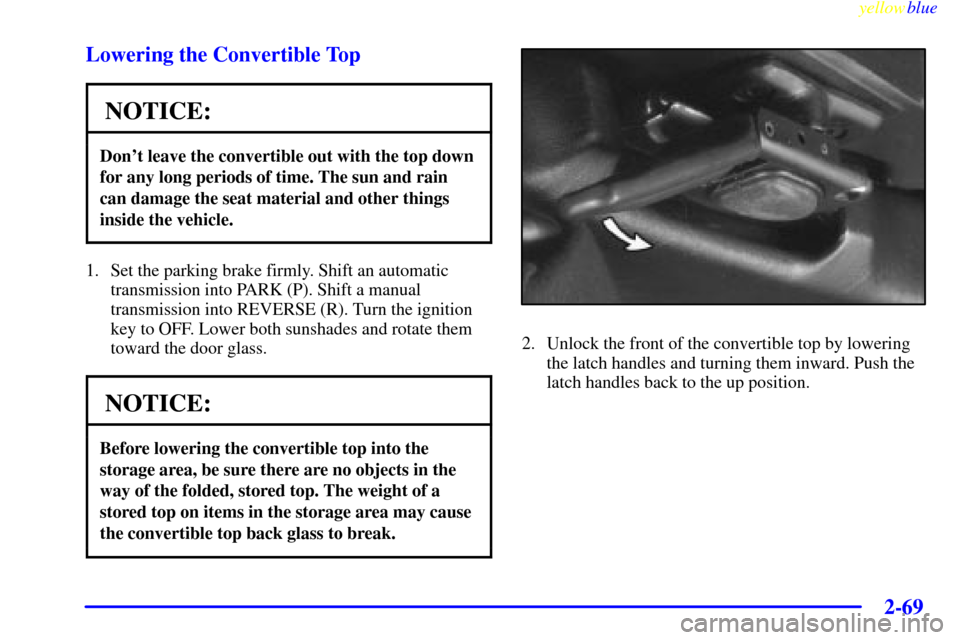
yellowblue
2-69 Lowering the Convertible Top
NOTICE:
Don't leave the convertible out with the top down
for any long periods of time. The sun and rain
can damage the seat material and other things
inside the vehicle.
1. Set the parking brake firmly. Shift an automatic
transmission into PARK (P). Shift a manual
transmission into REVERSE (R). Turn the ignition
key to OFF. Lower both sunshades and rotate them
toward the door glass.
NOTICE:
Before lowering the convertible top into the
storage area, be sure there are no objects in the
way of the folded, stored top. The weight of a
stored top on items in the storage area may cause
the convertible top back glass to break.
2. Unlock the front of the convertible top by lowering
the latch handles and turning them inward. Push the
latch handles back to the up position.
Page 122 of 376
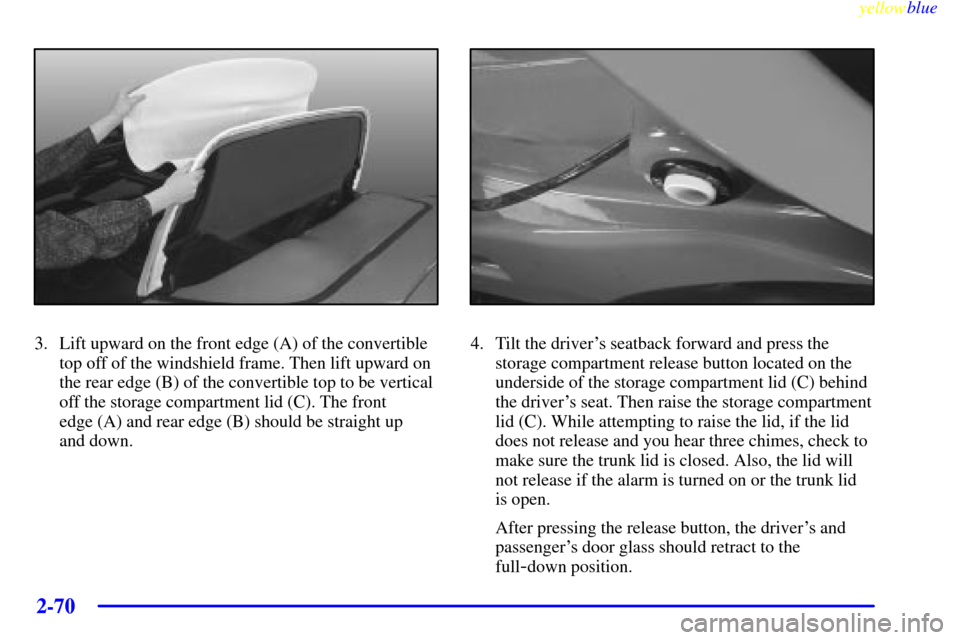
yellowblue
2-70
3. Lift upward on the front edge (A) of the convertible
top off of the windshield frame. Then lift upward on
the rear edge (B) of the convertible top to be vertical
off the storage compartment lid (C). The front
edge (A) and rear edge (B) should be straight up
and down.4. Tilt the driver's seatback forward and press the
storage compartment release button located on the
underside of the storage compartment lid (C) behind
the driver's seat. Then raise the storage compartment
lid (C). While attempting to raise the lid, if the lid
does not release and you hear three chimes, check to
make sure the trunk lid is closed. Also, the lid will
not release if the alarm is turned on or the trunk lid
is open.
After pressing the release button, the driver's and
passenger's door glass should retract to the
full
-down position.
Page 123 of 376
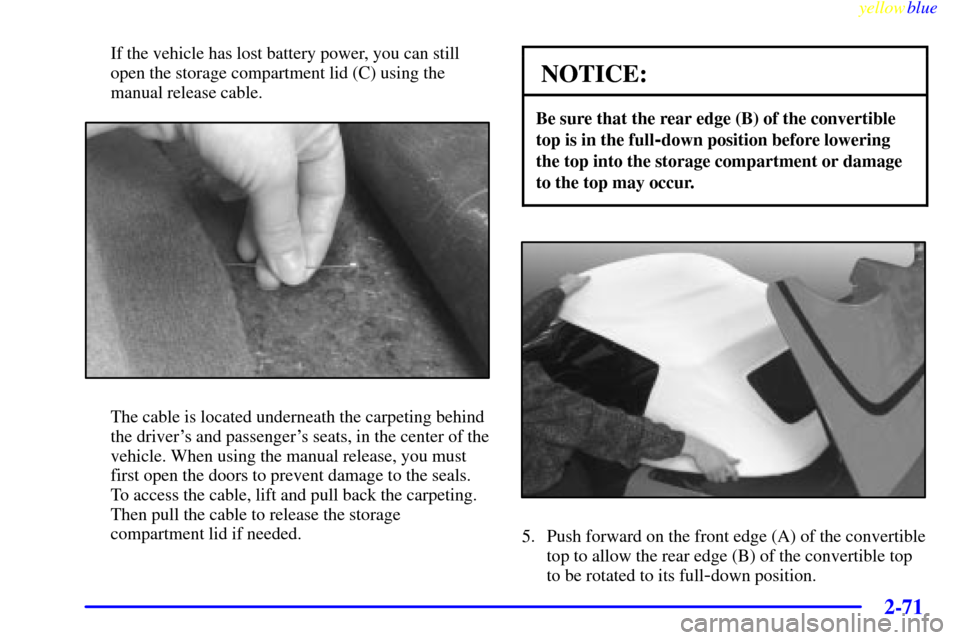
yellowblue
2-71
If the vehicle has lost battery power, you can still
open the storage compartment lid (C) using the
manual release cable.
The cable is located underneath the carpeting behind
the driver's and passenger's seats, in the center of the
vehicle. When using the manual release, you must
first open the doors to prevent damage to the seals.
To access the cable, lift and pull back the carpeting.
Then pull the cable to release the storage
compartment lid if needed.
NOTICE:
Be sure that the rear edge (B) of the convertible
top is in the full
-down position before lowering
the top into the storage compartment or damage
to the top may occur.
5. Push forward on the front edge (A) of the convertible
top to allow the rear edge (B) of the convertible top
to be rotated to its full
-down position.
Page 124 of 376
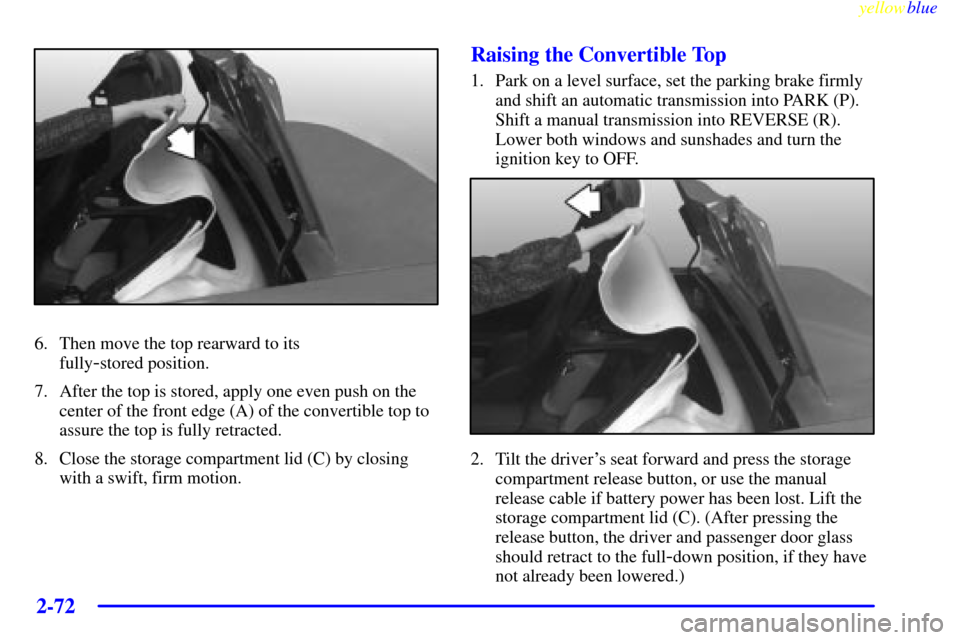
yellowblue
2-72
6. Then move the top rearward to its
fully
-stored position.
7. After the top is stored, apply one even push on the
center of the front edge (A) of the convertible top to
assure the top is fully retracted.
8. Close the storage compartment lid (C) by closing
with a swift, firm motion.
Raising the Convertible Top
1. Park on a level surface, set the parking brake firmly
and shift an automatic transmission into PARK (P).
Shift a manual transmission into REVERSE (R).
Lower both windows and sunshades and turn the
ignition key to OFF.
2. Tilt the driver's seat forward and press the storage
compartment release button, or use the manual
release cable if battery power has been lost. Lift the
storage compartment lid (C). (After pressing the
release button, the driver and passenger door glass
should retract to the full
-down position, if they have
not already been lowered.)
Page 125 of 376
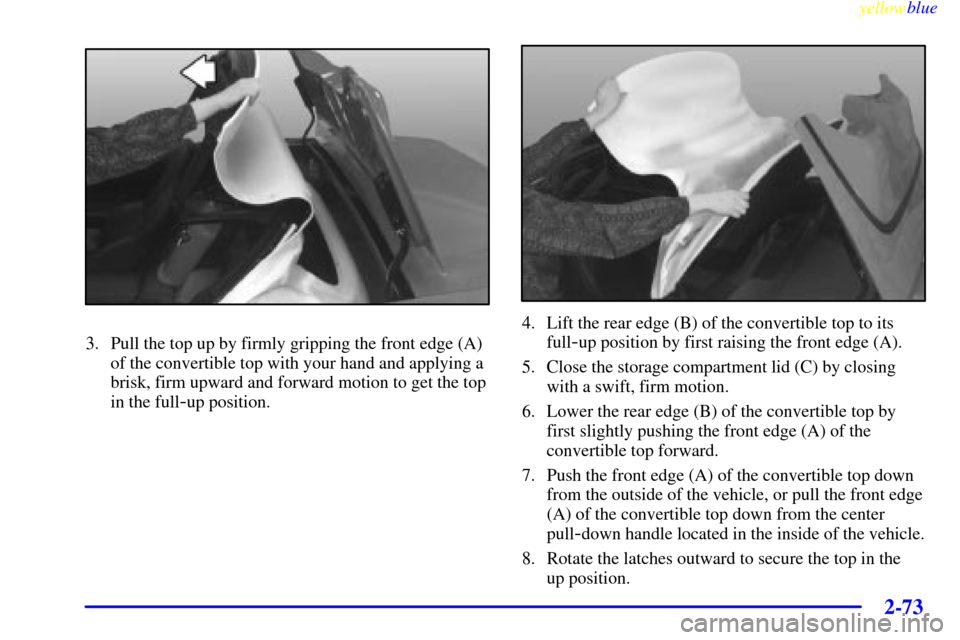
yellowblue
2-73
3. Pull the top up by firmly gripping the front edge (A)
of the convertible top with your hand and applying a
brisk, firm upward and forward motion to get the top
in the full
-up position.
4. Lift the rear edge (B) of the convertible top to its
full
-up position by first raising the front edge (A).
5. Close the storage compartment lid (C) by closing
with a swift, firm motion.
6. Lower the rear edge (B) of the convertible top by
first slightly pushing the front edge (A) of the
convertible top forward.
7. Push the front edge (A) of the convertible top down
from the outside of the vehicle, or pull the front edge
(A) of the convertible top down from the center
pull
-down handle located in the inside of the vehicle.
8. Rotate the latches outward to secure the top in the
up position.
Page 126 of 376

yellowblue
2-74
The Instrument Panel -- Your Information System
Page 127 of 376

yellowblue
2-75
The main components of your instrument panel are:
A. HUD Controls (Option)
B. Turn Signal/Multifunction Lever
C. Driver Information Center (DIC)
(Located in the Instrument Cluster)
D. Instrument Panel Cluster
E. Windshield Wiper/Washer Lever
F. Driver Information Center (DIC) Buttons
G. Hazard Warning Flasher Button
H. Center Air Vent
I. Audio System
J. Comfort Controls
K. Fog Lamp Button (Option)
L. Remote Hatch Release Button (Coupe) or Remote
Trunk Release Button (Convertible/Hardtop)M. Ignition Switch
N. Shift Lever (Automatic Shown)
O. Traction Control System (TCS) Switch/Active
Handling Switch (Option)
P. Accessory Power Outlet
(Located in the Center Console)
Q. Selective Real Time Damping (SRTD) (Option)
R. Instrument Panel Cupholder
S. Remote Fuel Door Release Button
(Located in the Center Console)
T. Ashtray and Cigarette Lighter
U. Parking Brake
V. Glove Box
W. Instrument Panel Fuse Block
Page 128 of 376

yellowblue
2-76
Instrument Panel Cluster
Your instrument panel cluster and Driver Information Center (DIC) are designed to let you know at a glance how the
vehicle is running. You'll know how fast you're going, about how much fuel you have left and many other things
you'll need to know to drive safely and economically. The instrument panel cluster indicator warning lights, gages
and DIC messages are explained on the following pages.
Page 129 of 376

yellowblue
2-77 Speedometer and Odometer
Your speedometer lets you see your speed in either miles
per hour (mph) or kilometers per hour (km/h).
You may note that there are not two separate scales for
mph and km/h. When you press the E/M
(English/Metric) button on the Driver Information
Center (DIC), the cluster will calculate the proper speed
and move the needle to the correct position. Either the
MPH or the km/h telltale will illuminate, depending on
which measurement you choose.
You may wonder what happens if your vehicle needs a
new odometer installed. If the new one can be set to the
mileage total of the old odometer, then that will be done.
If it can't, then a new instrument cluster is replaced in
the vehicle and a label must be put on the driver's door
to show the old mileage reading when the new odometer
was installed. See your dealer if a new odometer must
be replaced in your vehicle.
Tachometer
The tachometer displays the engine speed in thousands
of revolutions per minute (rpm).
Fuel will shut off at about 6200 rpm.
If you continue to drive your vehicle at the fuel shut off
rpm, you could damage your engine. Be sure to operate
your vehicle below the fuel shut off rpm or reduce your
rpm quickly when the fuel shuts off.
Warning Lights, Gages and Messages
This part describes the warning lights and gages that
may be on your vehicle. The pictures will help you
locate them.
Warning lights and gages can signal that something is
wrong before it becomes serious enough to cause an
expensive repair or replacement. Paying attention to
your warning lights and gages could also save you or
others from injury.
Warning lights come on when there may be or is a
problem with one of your vehicle's functions. As you
will see in the details on the next few pages, some
warning lights come on briefly when you start the
engine just to let you know they're working. If you are
familiar with this section, you should not be alarmed
when this happens.
Page 130 of 376

yellowblue
2-78
Gages can indicate when there may be or is a problem
with one of your vehicle's functions. Often gages and
warning lights work together to let you know when
there's a problem with your vehicle.
When one of the warning lights comes on and stays on
when you are driving, or when one of the gages shows
there may be a problem, check the section that tells you
what to do about it. Please follow this manual's advice.
Waiting to do repairs can be costly
-- and even
dangerous. So please get to know your warning lights
and gages. They're a big help.
Your vehicle also has a Driver Information Center that
works along with the warning lights and gages. See
ªDriver Information Center (DIC)º in the Index.
Safety Belt Reminder Light
When the key is turned to ON or START, a chime will
come on for about eight seconds to remind people to
fasten their safety belts, unless the driver's safety belt is
already buckled.
The safety belt light will
also come on and stay
on until the driver's belt
is buckled.
Air Bag Readiness Light
There is an air bag readiness light on the instrument
panel, which shows a deployed air bag symbol. The
system checks the air bag's electrical system for
malfunctions. The light tells you if there is an electrical
problem. The system check includes the air bag sensors,
the air bag modules, the wiring and the diagnostic
module. For more information on the air bag system, see
ªAir Bagº in the Index.
This light will come on
when you start your engine,
and it will flash for a few
seconds. Then the light
should go out. This means
the system is ready.